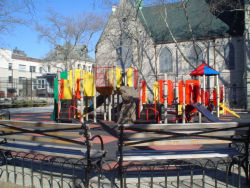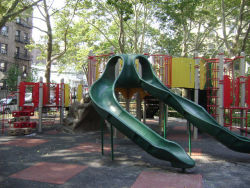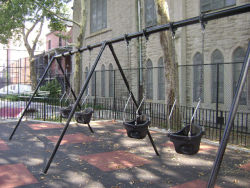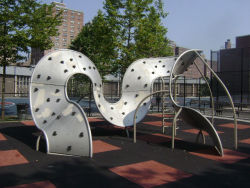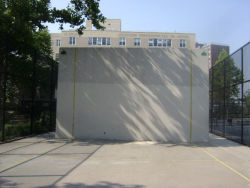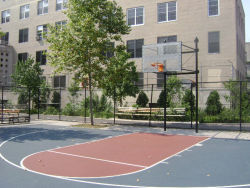Drew Playground
Drew Playground
Located on Fulton Avenue between East 169th and East 170th Street, this playground is one of the city’s oldest public spaces, serving as an open recreation area for more than 150 years. It was originally named Fulton Park after the American steamboat pioneer Robert Fulton (1765-1815) and the adjacent avenue of that name. On June 18, 1987, Commissioner Stern renamed the property Drew Playground in remembrance of Daniel Drew (1797-1879), a lesser-known steamboat entrepreneur. Drew was born in Carmel, New York, where he spent his early life on a farm and attended a rural school. After achieving considerable success in the cattle industry, he moved to New York City in 1829. In 1834, Drew purchased a large number of shares in the New York-to-Peekskill steamboat line -- a company he hoped would compete with the boats of industrialist and financier Cornelius Vanderbilt (1794-1877). Drew founded another steamship company, the People’s Line, in 1840. In 1844, he turned his attention to railroads and founded Drew, Robinson, and Company -- a Wall Street investment firm that became one of the foremost traders of railroad stocks. In 1847, he founded a third steamship company named the Stonington Line. In 1857, Daniel Drew was named director and treasurer of the Erie Railroad. Between 1866 and 1868, he engaged Vanderbilt in the “Erie War” for control of the assets of the Erie Railroad. Unfortunately for Drew, Vanderbilt cornered the steamship market by 1870, and Drew was ruined. His remaining fortune was erased following the economic panic of 1873. Daniel Drew, who lived the remainder of his life in Manhattan, has come to represent the archetypal “robber baron” of the 19th century.
Drew Playground is situated within the Bronx neighborhood of Morrisania, which is bounded by the Cross Bronx Expressway, Prospect Avenue, East 161st Street, and Webster Avenue. The Morris family acquired the area in 1670 by purchasing the estate of Jonas Bronck (the namesake of The Bronx). Gouverneur Morris (1752-1816) grew up here, and became one of the leading American politicians during and after the American Revolution. Witty and urbane, his greatest achievement was writing the final draft of the Constitution, and giving the document its coherent form and elegant language. In 1790, Gouverneur’s half-brother and fellow signer of the Declaration of Independence, Lewis Morris (1726-1798), proposed Morrisana as the site for the federal capital of the newly formed United States of America. In 1840, Gouverneur’s son, Gouverneur Morris Jr., allowed a railroad to be built through the estate and sold a nearby site to realtors as the Village of Morrisania in 1848.
Drew Playground first appeared on an 1848 map of the Village of Morrisania as a public square. In 1864, the estate of Gouveneur Morris ceded the property to the Trustees of the Town of Morrisania to be used for park purposes only. At that time, Morrisania was still part of Westchester County. In 1870, the newly created New York City Department of Public Parks was granted the power to extend mapping throughout West Farms and Morrisania. This re-mapping was favored by residents who saw their economic interests as more in line with those of Manhattan than Westchester County. The City of New York annexed the Town of Morrisania on Jan 1, 1874 as part of the newly created 23rd ward. Parks assumed jurisdiction over Drew Playground on day of acquisition.
In November 1995, Drew Playground received a $42,370 requirements contract upgrade sponsored by Mayor Rudolph W. Giuliani that included the installation of safety surfacing. Mayor Giuliani sponsored an additional $42,000 requirements contract upgrade in January 1997 that restored the handball courts and replaced worn fencing. Today, the playground includes a public restroom, benches, handball and basketball courts, swings, assorted play equipment, slides, and game tables.
Check out your park's Vital Signs
Clean & Safe
Green & Resilient
Empowered & Engaged Users
Share your feedback or learn more about how this park is part of a
Vital Park System


